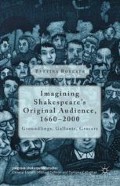Abstract
In 1935, William John Lawrence published a collection of essays called Those Nut-Cracking Elizabethans.1 To the specialist audience at which it is aimed, the fact that the book focusses on the Elizabethans in their capacity as theatregoers need hardly be mentioned: a nut-cracking Elizabethan is, by definition, located in the theatre. This assumption is part of a whole set of sometimes surprisingly specific and detailed beliefs about the Elizabethan audience current among both amateurs of and specialists in Shakespearean drama. Perhaps the most persistent of these tenets is that Shakespeare wrote certain passages (not necessarily his best) especially for those who had paid for standing room only — the notorious ‘groundlings’. Over the centuries, a plethora of critics has claimed that this was a section of the audience of which he did not think too highly, citing the following passage from Hamlet as proof:
Hamlet: […] O! it offends me to the soul to hear a robustious periwig-pated fellow tear a passion to tatters, to very rags, to split the ears of the groundlings, who, for the most part, are capable of nothing but inexplicable dumb-shows and noise.2
Access this chapter
Tax calculation will be finalised at checkout
Purchases are for personal use only
Preview
Unable to display preview. Download preview PDF.
Notes
William John Lawrence, Those Nut-cracking Elizabethans: Studies of the Early Theatre and Drama, London: Macmillan, 1935.
William Shakespeare, The Norton Shakespeare: Hamlet, Stephen Greenblatt (general ed.), New York: W. W. Norton & Company, 2008, III, ii: 8–12.
William Shakespeare, The Norton Shakespeare: Henry V, Stephen Greenblatt (general ed.), New York: W. W. Norton & Company, 2008, Prol. III, 25.
Jeremy Lopez, ‘Imagining the Actor’s Body on the Early Modern Stage’, Medieval and Renaissance Drama in England 20, 2007, 187–203: 189.
Michael Dobson, The Making of the National Poet: Shakespeare, Adaptation and Authorship, 1660–1769, Oxford: Clarendon Press, 1992.
The phrase is, of course, Gary Taylor’s. (Gary Taylor, Reinventing Shakespeare: A Cultural History from the Restoration to the Present, London: Hogarth Press, 1990).
Nova Myhill and Jennifer A. Low, ‘Introduction: Audience and Audiences’, Nora Myhill and Jennifer A. Low (eds.), Imagining the Audience in Early Modern Drama, 1558–1642, New York: Palgrave Macmillan, 2011, 1–17: 2.
William Empson ‘The Globe Theatre’, Essays on Shakespeare, Cambridge: Cambridge University Press, 1986, 158–222: 159.
Robert Shaughnessy, ‘Introduction’, Robert Shaughnessy (ed.), The Cambridge Companion to Shakespeare and Popular Culture, Cambridge: Cambridge University Press, 2007, 1–5: 2.
See E. K. Chambers, The Elizabethan Stage, vol. 1, Oxford: Oxford University Press, 1923, esp. 236–307 and related appendices.
Ann Jennalie Cook, The Privileged Playgoers of Shakespeare’s London, 1576–1642, Princeton: Princeton University Press, 1981, 3.
E. M. W. Tillyard, The Elizabethan World Picture, London: Macmillan, 1943.
Identity, alterity, authenticity
That hetero-stereotype and auto-stereotype are inextricably intertwined is a commonplace of research in the field. Hans Henning Hahn, amongst others, points out that the one in fact conditions the other (‘einander bedingen’, my translation). See Eva and Hans Henning Hahn, ‘Nationale Stereotypen: Plädoyer für eine historische Stereotypenforschung’, Hans Henning Hahn (ed.), Stereotyp, Identität und Geschichte: Die Funktion von Stereotypen in gesellschaftlichen Diskursen (Mitteleuropa-Osteuropa: Oldenburger Beiträge zur Kultur und Geschichte Ostmitteleuropas, vol. 5), Frankfurt/Main: Peter Lang, 2002, 17–56: 28.
Sander L. Gilman, Difference and Pathology: Stereotypes of Sexuality, Race, and Madness. Ithaca and London: Cornell University Press, 1985, 20.
Simon Shepherd, Peter Womack, English Drama: A Cultural History, Oxford: Blackwell, 1996, 90–91.
Moody E. Prior, ‘The Elizabethan Audience and the Plays of Shakespeare’, Modern Philology 49, 1951–52, 101–23: 102–03.
Amy Rodgers, ‘Looking Up to the Groundlings: Representing the Renaissance Audience in Contemporary Fiction and Film’, Greg M. Colón Semenza (ed.), The English Renaissance in Popular Culture: An Age for All Time, New York: Palgrave Macmillan, 2010, 75–87.
See Rodgers and Stephen Purcell’s Popular Shakespeare: Simulation and Subversion on the Modern Stage, Basingstoke: Palgrave Macmillan, 2009, 158–64.
On New Globe audiences more generally, see Paul Prescott, ‘Inheriting the Globe: The Reception of Shakespearean Space and Audience in Contemporary Reviewing’, Barbara Hodgdon and W. B. Worthen (eds.), A Companion to Shakespeare and Performance, Malden and Oxford: Blackwell, 2005, 359–75.
See also Christie Carson, ‘Democratising the Audience?’, Christie Carson and Farah Karim-Cooper (eds.), Shakespeare’s Globe: A Theatrical Experiment, Cambridge: Cambridge University Press, 2008, 115–26.
Michael D. Bristol, Shakespeare’s America, America’s Shakespeare, London/New York: Routledge, 1990, 47.
On the idea of the audience in the Original Practice movement, see Jeremy Lopez, ‘A Partial Theory of Original Practice’, Shakespeare Survey 61, 2008, 302–17.
Author information
Authors and Affiliations
Copyright information
© 2015 Bettina Boecker
About this chapter
Cite this chapter
Boecker, B. (2015). Introduction: Those Nut-cracking Elizabethans. In: Imagining Shakespeare’s Original Audience, 1660–2000. Palgrave Shakespeare Studies. Palgrave Macmillan, London. https://doi.org/10.1057/9781137379962_1
Download citation
DOI: https://doi.org/10.1057/9781137379962_1
Publisher Name: Palgrave Macmillan, London
Print ISBN: 978-1-349-56325-8
Online ISBN: 978-1-137-37996-2
eBook Packages: Palgrave Media & Culture CollectionLiterature, Cultural and Media Studies (R0)

